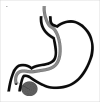How to improve the success of endoscopic ultrasound guided fine needle aspiration cytology in the diagnosis of pancreatic lesions
- PMID: 22586548
- PMCID: PMC3350908
- DOI: 10.4161/jig.20132
How to improve the success of endoscopic ultrasound guided fine needle aspiration cytology in the diagnosis of pancreatic lesions
Abstract
Endoscopic ultrasonography (EUS) is highly accurate for assessing the pancreatic parenchyma and ductal system. Currently, it is the most sensitive imaging procedure for detecting small solid pancreatic masses. EUS-guided fine needle aspiration cytology (EUS-FNA) is a safe and highly accurate tool for the diagnosis of pancreatic malignancy. Prior to perform an EUS-FNA one should wonder whether the benefits outweigh the potential risks of the procedure. Therefore, it is important to take into account whether the procedure will influence patient management. The diagnostic yield and success rate of EUS-FNA in pancreatic lesions varies greatly depending on many factors including: the characteristics of the lesion itself (location of the mass and consistency of the lesion), technical factors (type of needle size, use of stylet, use of suction and number of needle passes performed) and the availability of immediate cytological assessment of the specimen. The aim of this review is to analyze all these factors for optimizing specimen collection and diagnostic efficiency in dealing with solid pancreatic masses.
Keywords: diagnosis; endoscopic ultrasound guided fine needle aspiration cytology; pancreatic lesions.
Figures



Similar articles
-
Relationship of pancreatic mass size and diagnostic yield of endoscopic ultrasound-guided fine needle aspiration.Dig Dis Sci. 2011 Nov;56(11):3370-5. doi: 10.1007/s10620-011-1782-z. Epub 2011 Jun 19. Dig Dis Sci. 2011. PMID: 21688127
-
Touch imprint cytology on endoscopic ultrasound fine-needle biopsy provides comparable sample quality and diagnostic yield to standard endoscopic ultrasound fine-needle aspiration specimens in the evaluation of solid pancreatic lesions.Cytopathology. 2019 Mar;30(2):179-186. doi: 10.1111/cyt.12662. Epub 2018 Dec 21. Cytopathology. 2019. PMID: 30484917
-
Comparing endoscopic ultrasound (EUS)-guided fine needle aspiration (FNA) versus fine needle biopsy (FNB) in the diagnosis of solid lesions: study protocol for a randomized controlled trial.Trials. 2016 Apr 12;17:198. doi: 10.1186/s13063-016-1316-2. Trials. 2016. PMID: 27071386 Free PMC article. Clinical Trial.
-
Endoscopic ultrasonography guided-fine needle aspiration for the diagnosis of solid pancreaticobiliary lesions: Clinical aspects to improve the diagnosis.World J Gastroenterol. 2016 Jan 14;22(2):628-40. doi: 10.3748/wjg.v22.i2.628. World J Gastroenterol. 2016. PMID: 26811612 Free PMC article. Review.
-
Basic technique in endoscopic ultrasound-guided fine needle aspiration for solid lesions: How many passes?Endosc Ultrasound. 2014 Jan;3(1):22-7. doi: 10.4103/2303-9027.124310. Endosc Ultrasound. 2014. PMID: 24949407 Free PMC article. Review.
Cited by
-
Evaluation of 22G fine-needle aspiration (FNA) versus fine-needle biopsy (FNB) for endoscopic ultrasound-guided sampling of pancreatic lesions: a prospective comparison study.Surg Endosc. 2018 Aug;32(8):3533-3539. doi: 10.1007/s00464-018-6075-6. Epub 2018 Feb 5. Surg Endosc. 2018. PMID: 29404729 Free PMC article. Clinical Trial.
-
A Blood-Based Multi Marker Assay Supports the Differential Diagnosis of Early-Stage Pancreatic Cancer.Theranostics. 2019 Feb 12;9(5):1280-1287. doi: 10.7150/thno.29247. eCollection 2019. Theranostics. 2019. PMID: 30867830 Free PMC article.
-
Repeat endoscopic ultrasound fine needle aspiration after a first negative procedure is useful in pancreatic lesions.Endosc Ultrasound. 2016 Jul-Aug;5(4):258-62. doi: 10.4103/2303-9027.187889. Endosc Ultrasound. 2016. PMID: 27503159 Free PMC article.
-
Comparison of specimen quality among the standard suction, slow-pull, and wet suction techniques for EUS-FNA: A multicenter, prospective, randomized controlled trial.Endosc Ultrasound. 2022 Sep-Oct;11(5):393-400. doi: 10.4103/EUS-D-21-00163. Endosc Ultrasound. 2022. PMID: 36255027 Free PMC article.
-
Post-brushing and fine-needle aspiration biopsy follow-up and treatment options for patients with pancreatobiliary lesions: The Papanicolaou Society of Cytopathology Guidelines.Cytojournal. 2014 Jun 2;11(Suppl 1):5. doi: 10.4103/1742-6413.133356. eCollection 2014. Cytojournal. 2014. PMID: 25191519 Free PMC article.
References
-
- Crowe DR, Eloubeidi MA, Chhieng DC, Jhala NC, Jhala D, Eltoum IA. Fine-needle aspiration biopsy of hepatic lesions: computerized tomographic-guided versus endoscopic ultrasound-guided FNA. Cancer. 2006;108:180–185. - PubMed
-
- Nguyen P, Feng JC, Chang KJ. Endoscopic ultrasound (EUS) and EUS-guided fineneedle aspiration (FNA) of liver lesions. Gastrointest Endosc. 1999;50:357–361. - PubMed
-
- Paquin SC, Gariepy G, Lepanto L, Bourdages R, Raymond G, Sahai AV. A first report of tumor seeding because of EUS-guided FNA of a pancreatic adenocarcinoma. Gastrointest Endosc. 2005;61:610–611. - PubMed
-
- Eloubeidi MA, Chen VK, Eltoum IA, Jhala D, Chhieng DC, Jhala N, et al. Endoscopic ultrasound-guided fine needle aspiration biopsy of patients with suspected pancreatic cancer: diagnostic accuracy and acute and 30-day complications. Am J Gastroenterol. 2003;98:2663–2668. - PubMed
Publication types
LinkOut - more resources
Full Text Sources
